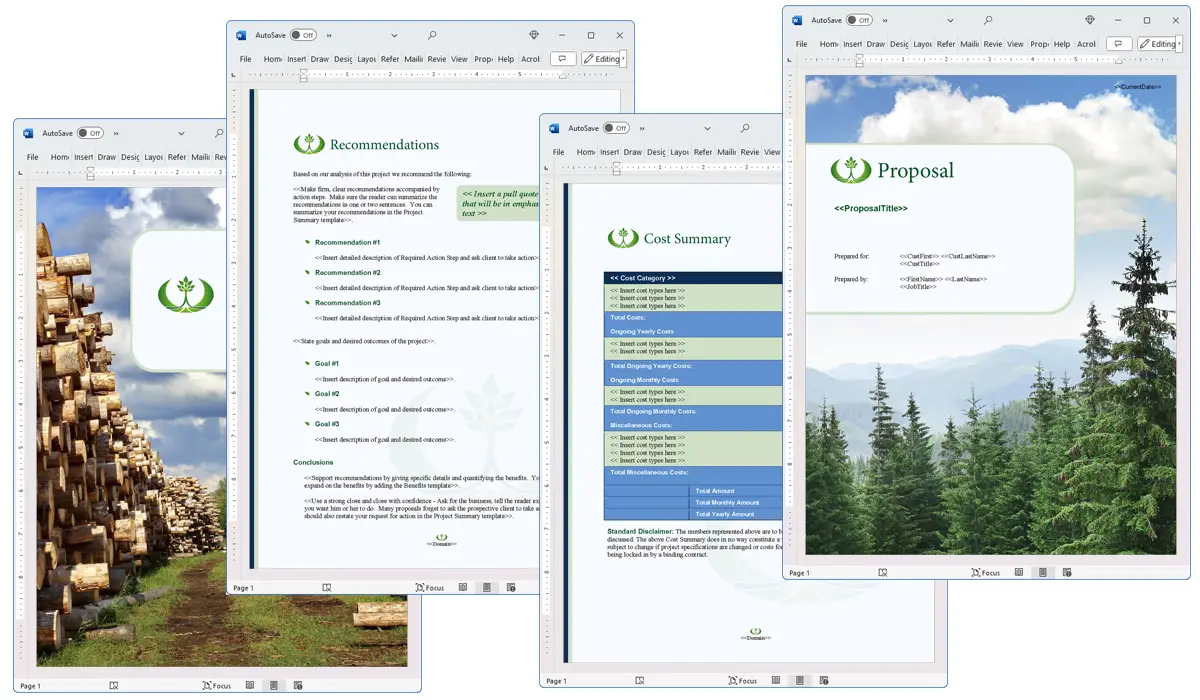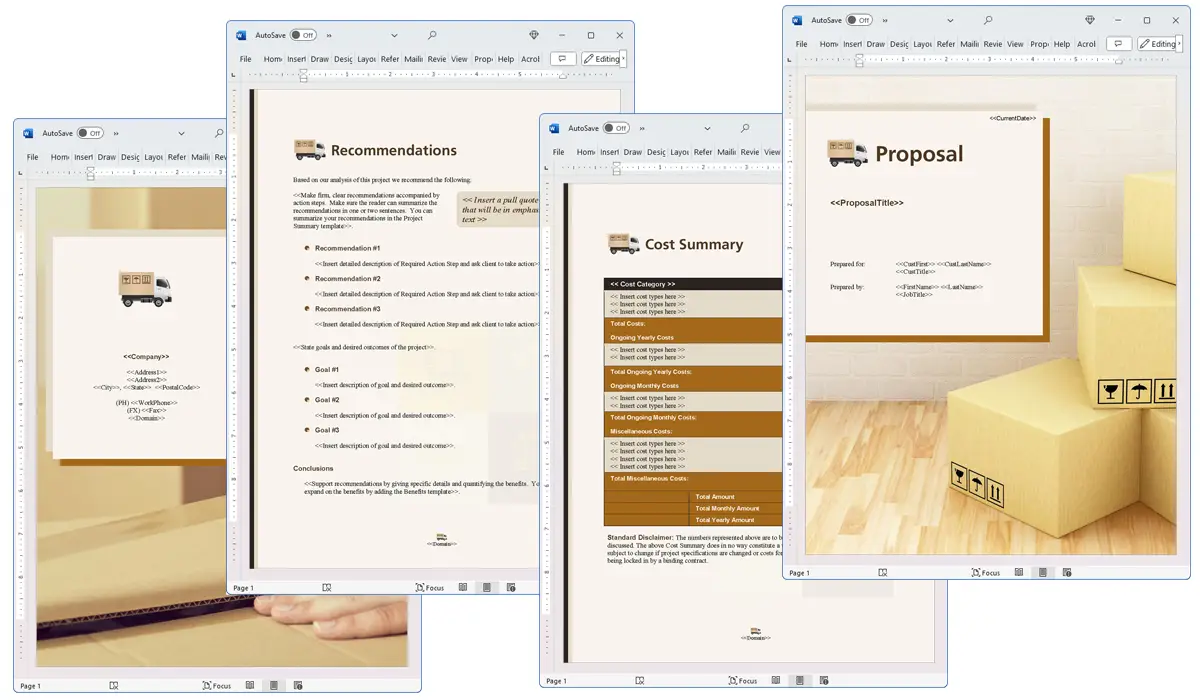What is the Testing chapter used for?
Proposal Kit Professional Bundle adds more design themes, all six Contract Packs,
a project management library, and Expert Edition software.

Illustration of Proposal Pack Resources #1
We include this Testing chapter template in every Proposal Pack, along with thousands more. You assemble this chapter with others in various combinations to create custom-tailored business proposals, plans, reports, and other documents. Proposal Packs apply custom visual designs to the templates, giving the final documents a consistent professional finish.
 DOWNLOADABLE, ONE-TIME COST, NO SUBSCRIPTION FEES
DOWNLOADABLE, ONE-TIME COST, NO SUBSCRIPTION FEES
Overview of the Testing Chapter
The Testing chapter in a proposal document is an important component that outlines the methodologies and strategies for evaluating the effectiveness of a project, product, or educational program. This chapter allows the proposal writer to detail the specific tests that will be conducted to measure outcomes effectively. This information can help stakeholders understand how the results will be gathered and analyzed, ensuring that the proposed methods are sound and reliable.
How is the Testing Chapter Used?
In a business proposal, the Testing chapter is used to provide a clear and detailed plan for how various aspects of the project or product will be tested to meet the objectives set forth in the proposal. It sets the stage for demonstrating the project's credibility and feasibility by outlining the steps that will be taken to ensure that the outcomes can be measured accurately. This chapter is crucial for building confidence among potential clients, investors, or internal leadership by showing that the project can meet its stated goals through rigorous testing procedures.
What is Included in the Testing Chapter?
Typically, the Testing chapter includes several key elements:
- Objectives of Testing: Clearly defined goals that the testing phase aims to achieve.
- Testing Methods: Description of the methodologies and techniques that will be used for testing.
- Timeline: Schedule and phases of testing throughout the project lifecycle.
- Expected Results: What results are anticipated from the testing phase.
- Evaluation Criteria: Benchmarks and standards against which the results will be evaluated.
- Risk Management: Potential risks identified during testing and the strategies for managing them.
Use Case Examples for the Testing Chapter
- Educational Programs: Detailing how students' understanding and skills will be assessed through tests and practical exams to ensure learning objectives are met.
- Software Development: Describing the phases of beta testing and bug fixing to ensure the software meets user requirements before full release.
- Product Development: Outlining test runs for a new product to check its durability, functionality, and consumer appeal before mass production.
- Research Studies: Explaining the control and experimental setups in clinical trials to evaluate the effectiveness of new medical treatments.
- Quality Control: Detailing the inspection and compliance checks for manufacturing processes to uphold product quality standards.
Key Takeaways
- The Testing chapter is important in proposals to outline how project goals will be measured and validated.
- It builds trust among stakeholders by detailing a structured approach to achieving verifiable results.
- This chapter typically includes objectives, methods, timeline, expected results, evaluation criteria, and risk management.
- It has applications across various industries, including education, software, product development, research, and quality control.
- Effective use of the Testing chapter demonstrates meticulous planning and a commitment to delivering reliable, high-quality outcomes.

Illustration of Proposal Pack Elegant #5
 What Our Clients Say
What Our Clients SayAn excellent product, definitely worth the small investment. I spent over 10 years building proposals from scratch for the food service industry and although I had some success I was never entirely happy with the end result. I bought the Proposal Pack Wizard about 2 years ago I was finally able to produce great looking documents with the professional image that I needed. The response to the new format was excellent and I was able to win more business, even when competing with much larger competitors."
 4.7 stars, based on 849 reviews
4.7 stars, based on 849 reviewsAlternate Chapters
Related Chapters
Samples Using the Testing Chapter
Document Layouts Using the Testing Chapter
- In-House Lab to Save Costs and Protect Trade Secrets Proposal
- Modeling and Simulation Proposal Template
- Fire Safety Equipment Sales and Installation Proposal
- Waterline Cathodic Protection Program Proposal
- Fire Safety Construction Proposal
- Software Automation Proposal
- Fire Alarm and Security System Installation Proposal
- Quality Assurance Project Proposal
- Robotics Automation Project Proposal
- Elevator and Escalator Sales and Service Proposal
- Pilot Project Proposal
- Web Site Creation and Software Integration Project
- Testing and Inspection Services Proposal
- Restaurant Kiosk Automation Proposal
- Autonomous Vehicle Regulations Proposal
- Prototyping, Fabrication and Machining Services Proposal

The Testing chapter and other chapters are integrated into a Word document as illustrated here in the Proposal Pack Transportation #9 design theme. There are hundreds of design themes available, and every design theme includes the Testing chapter template.
A proper business proposal will include multiple chapters. This chapter is just one of many you can build into your proposal. We include the complete fill-in-the-blank template in our Proposal Pack template collections. We also include a library of sample proposals illustrating how companies in different industries, both large and small, have written proposals using our Proposal Packs. This template will show you how to write the Testing.
We include a chapter library for you to build from based on your needs. All proposals are different and have different needs and goals. Pick the chapters from our collection and organize them as needed for your proposal.
Using the Proposal Pack template library, you can create any business proposal, report, study, plan, or document.
The Wizard software includes an AI Writer, which will write the content of this and any other chapter of your document. Use the AI Writer to do the heavy lifting, writing the first draft of your proposal or business document in minutes.
 Ian Lauder has been helping businesses write their proposals and contracts for two decades. Ian is the owner and founder of Proposal Kit, one of the original sources of business proposal and contract software products started in 1997.
Ian Lauder has been helping businesses write their proposals and contracts for two decades. Ian is the owner and founder of Proposal Kit, one of the original sources of business proposal and contract software products started in 1997.By Ian Lauder
 Published by Proposal Kit, Inc.
Published by Proposal Kit, Inc.


 Cart
Cart
 Facebook
Facebook YouTube
YouTube Bluesky
Bluesky Search Site
Search Site